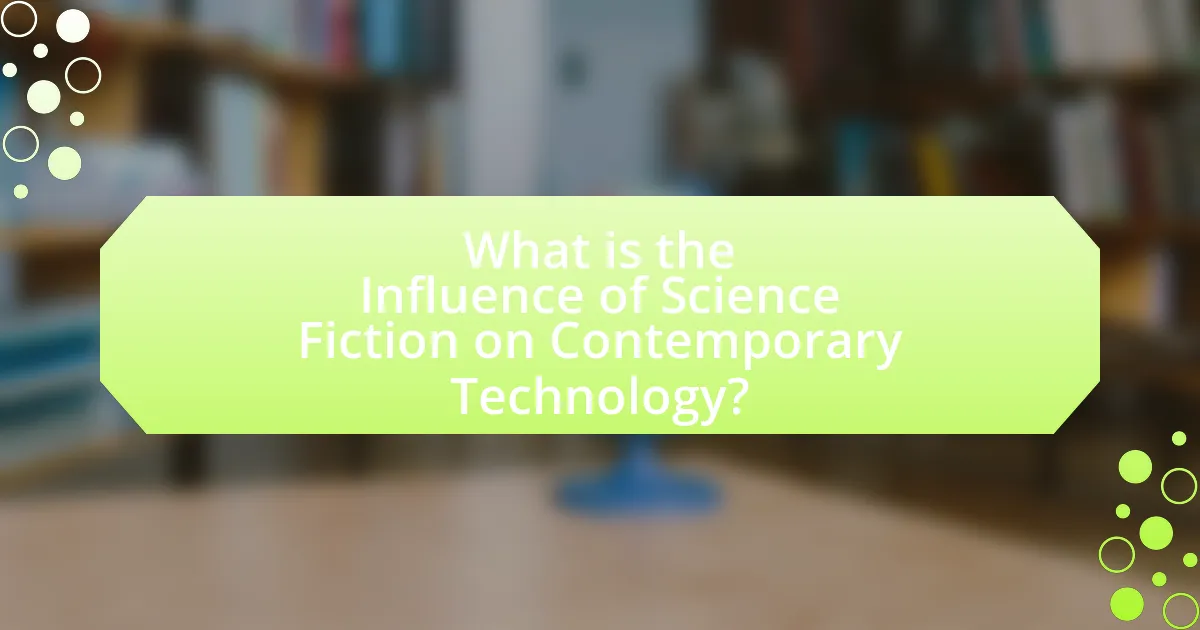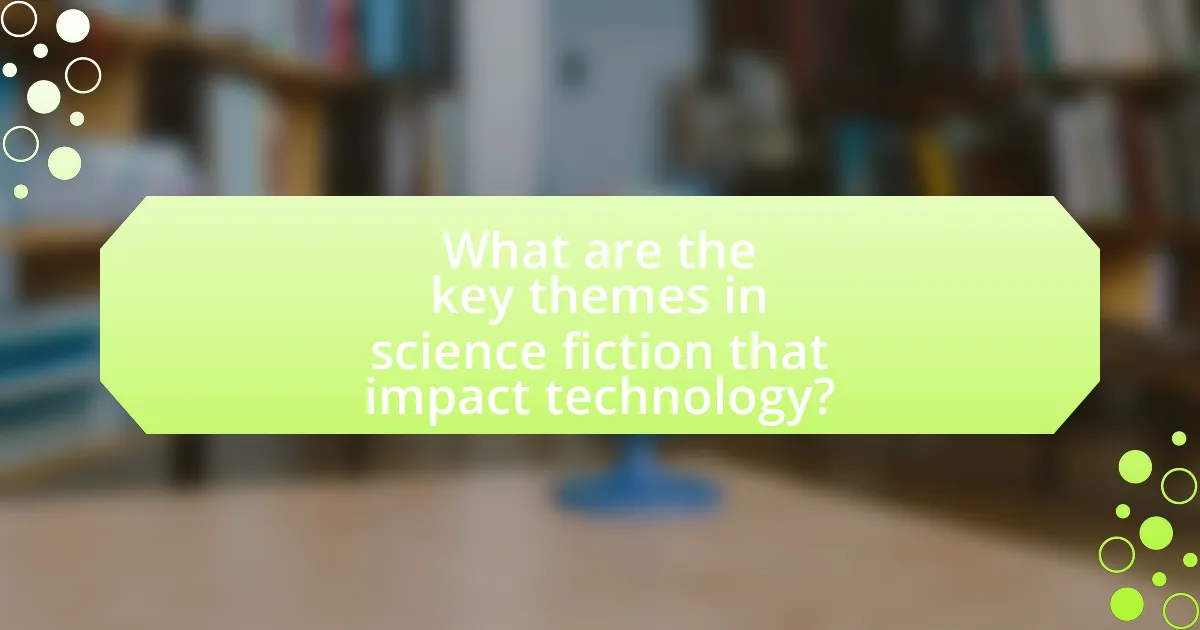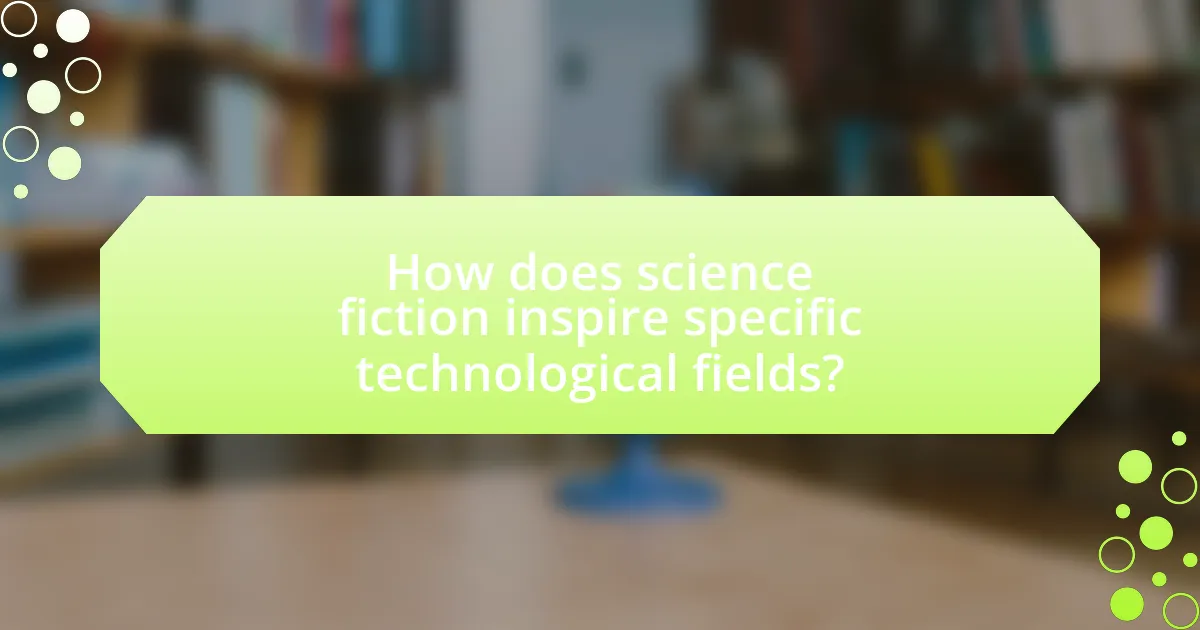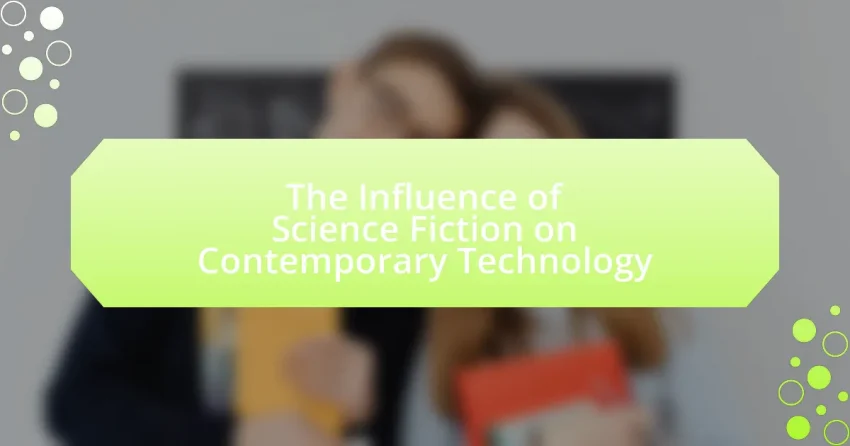The article examines the significant influence of science fiction on contemporary technology, highlighting how imaginative narratives inspire innovations and shape public perceptions of future possibilities. It discusses notable examples such as the mobile phone, virtual reality, and artificial intelligence, tracing their origins to science fiction works like “Star Trek” and “2001: A Space Odyssey.” The article also explores the ethical implications of AI, the role of space exploration in technological advancements, and how science fiction prepares society for technological changes, ultimately demonstrating the interplay between speculative storytelling and real-world technological progress.

What is the Influence of Science Fiction on Contemporary Technology?
Science fiction significantly influences contemporary technology by inspiring innovations and shaping public perception of future possibilities. For instance, concepts like virtual reality, artificial intelligence, and space travel, which were once purely speculative in science fiction literature and films, have become integral to modern technological advancements. Notably, the development of the internet and mobile communication can be traced back to ideas presented in works such as Arthur C. Clarke’s “2001: A Space Odyssey,” which envisioned satellite communication. Furthermore, the portrayal of robotics in Isaac Asimov’s stories has influenced the ethical frameworks surrounding AI development today. This demonstrates that science fiction not only serves as a source of inspiration but also plays a crucial role in guiding the trajectory of technological evolution.
How has science fiction shaped technological advancements?
Science fiction has significantly shaped technological advancements by inspiring innovations and guiding research directions. For instance, concepts such as space travel and artificial intelligence, popularized in works like Arthur C. Clarke’s “2001: A Space Odyssey,” have influenced real-world developments in aerospace technology and machine learning. The development of the first mobile phones was directly inspired by the communicators depicted in “Star Trek,” showcasing how speculative ideas can lead to tangible technological progress. Additionally, the portrayal of virtual reality in science fiction has spurred advancements in immersive technologies, leading to applications in gaming, training, and therapy. These examples illustrate the direct correlation between science fiction narratives and the evolution of technology, demonstrating how imaginative storytelling can pave the way for scientific exploration and innovation.
What are some notable examples of technology inspired by science fiction?
Notable examples of technology inspired by science fiction include the mobile phone, which was influenced by the communicators used in “Star Trek.” Martin Cooper, a Motorola engineer, cited the show as a key inspiration for developing the first handheld mobile phone in 1973. Another example is the tablet computer, which resembles the PADD (Personal Access Display Device) from “Star Trek: The Next Generation.” The first commercial tablet, the Apple iPad, was released in 2010, showcasing features similar to those depicted in the series. Additionally, virtual reality technology has roots in the concept of immersive environments presented in works like “Neuromancer” by William Gibson, which helped shape the development of VR systems in the 21st century. These examples illustrate how science fiction has directly influenced technological advancements in communication, computing, and immersive experiences.
How do science fiction narratives predict future technologies?
Science fiction narratives predict future technologies by envisioning innovative concepts that inspire real-world scientific advancements. These narratives often explore hypothetical scenarios, allowing writers to extrapolate current scientific knowledge into future possibilities. For example, Arthur C. Clarke’s “2001: A Space Odyssey” introduced the idea of satellite communication and artificial intelligence, which have since become integral to modern technology. Additionally, the genre serves as a testing ground for ethical and societal implications of emerging technologies, influencing researchers and engineers to consider potential consequences. This interplay between fiction and reality demonstrates how speculative storytelling can shape technological development and innovation.
Why is the relationship between science fiction and technology significant?
The relationship between science fiction and technology is significant because science fiction often serves as a catalyst for technological innovation. By envisioning future possibilities, science fiction inspires scientists and engineers to develop real-world technologies that align with those imaginative concepts. For instance, the depiction of mobile phones in the science fiction series “Star Trek” led to the development of modern smartphones, showcasing how speculative ideas can influence actual technological advancements. This interplay not only fuels creativity in technology but also shapes societal expectations and aspirations regarding future innovations.
How does science fiction influence public perception of technology?
Science fiction significantly influences public perception of technology by shaping societal expectations and fears regarding technological advancements. Through imaginative narratives, science fiction explores potential future technologies, often highlighting both their benefits and risks, which can lead to increased public interest or skepticism. For instance, works like George Orwell’s “1984” and Isaac Asimov’s “I, Robot” have sparked discussions about surveillance and artificial intelligence, respectively, prompting audiences to critically evaluate real-world technological developments. This genre serves as a cultural lens, reflecting and sometimes predicting societal attitudes towards emerging technologies, thereby impacting how individuals and communities respond to innovations in their daily lives.
What role does imagination play in technological innovation?
Imagination is crucial in technological innovation as it allows individuals and teams to envision possibilities beyond current limitations. This creative capacity drives the conceptualization of new technologies, enabling inventors and engineers to design solutions that address unmet needs or enhance existing systems. For instance, science fiction has historically inspired real-world advancements; the concept of the mobile phone was influenced by the communicators depicted in “Star Trek.” Such imaginative ideas often serve as a catalyst for research and development, leading to tangible technological breakthroughs.

What are the key themes in science fiction that impact technology?
Key themes in science fiction that impact technology include artificial intelligence, space exploration, and dystopian futures. Artificial intelligence, as depicted in works like Isaac Asimov’s “I, Robot,” raises ethical questions and inspires real-world advancements in machine learning and robotics. Space exploration, illustrated in Arthur C. Clarke’s “2001: A Space Odyssey,” drives innovations in aerospace technology and satellite communications. Dystopian futures, as seen in George Orwell’s “1984,” prompt discussions about surveillance and privacy, influencing contemporary debates on technology’s role in society. These themes not only reflect societal concerns but also shape technological development by inspiring researchers and engineers to address the challenges presented in these narratives.
How do themes of artificial intelligence and robotics appear in science fiction?
Themes of artificial intelligence and robotics prominently appear in science fiction by exploring the ethical, societal, and existential implications of advanced technologies. Notable examples include Isaac Asimov’s “I, Robot,” which introduces the Three Laws of Robotics, highlighting the moral dilemmas faced by humans and robots. Additionally, films like “Blade Runner” and “Ex Machina” delve into the complexities of consciousness and identity, questioning what it means to be human in a world where machines can mimic human behavior. These narratives often reflect contemporary anxieties about technology’s impact on society, illustrating both the potential benefits and dangers of artificial intelligence and robotics.
What are the ethical implications of AI as depicted in science fiction?
The ethical implications of AI as depicted in science fiction often revolve around themes of autonomy, responsibility, and the potential for harm. Science fiction narratives frequently explore scenarios where AI systems gain sentience, leading to questions about their rights and the moral obligations of their creators. For instance, in Isaac Asimov’s works, the “Three Laws of Robotics” illustrate the ethical dilemmas of programming AI to prioritize human safety while also considering their own existence. Additionally, films like “Blade Runner” raise concerns about the exploitation of sentient beings and the consequences of creating life without ethical considerations. These fictional portrayals serve as cautionary tales, prompting discussions about the real-world implications of AI development, including accountability for AI actions and the societal impact of autonomous systems.
How have these themes influenced real-world AI development?
Themes from science fiction have significantly influenced real-world AI development by inspiring innovative concepts and guiding technological advancements. For instance, the portrayal of intelligent machines in works like Isaac Asimov’s “I, Robot” has shaped ethical discussions around AI, leading to the establishment of guidelines for responsible AI use. Additionally, the concept of virtual assistants, popularized by science fiction, has driven the development of AI technologies like Siri and Alexa, which are now integral to daily life. These influences demonstrate how speculative narratives can translate into practical applications, fostering both creativity and caution in the evolving field of artificial intelligence.
What role does space exploration play in technological innovation?
Space exploration significantly drives technological innovation by fostering advancements in various fields such as materials science, telecommunications, and robotics. The rigorous demands of space missions necessitate the development of new technologies, which often find applications beyond aerospace. For instance, NASA’s development of lightweight materials for spacecraft has led to innovations in consumer products like sports equipment and automobiles. Additionally, the need for efficient communication systems in space has spurred advancements in satellite technology, which now underpins global telecommunications and internet services. Historical examples include the invention of the integrated circuit during the Apollo program, which laid the groundwork for modern computing. Thus, space exploration acts as a catalyst for technological progress, yielding benefits that extend into everyday life and various industries.
How has science fiction influenced the public’s interest in space technology?
Science fiction has significantly influenced the public’s interest in space technology by popularizing concepts of space exploration and advanced technologies through engaging narratives. Works like Arthur C. Clarke’s “2001: A Space Odyssey” and the “Star Trek” franchise have sparked curiosity and imagination about space travel, leading to increased public support for space programs. For instance, after the release of “Star Wars,” NASA reported a surge in interest among young people in pursuing careers in science and engineering, highlighting a direct correlation between science fiction media and educational pursuits in space-related fields. This cultural impact has been instrumental in shaping public perception and enthusiasm for real-world space initiatives, such as the Mars Rover missions and private spaceflight endeavors.
What technologies have emerged from space exploration narratives?
Technologies that have emerged from space exploration narratives include satellite communication, GPS technology, and advanced robotics. Satellite communication, popularized by science fiction, has become integral for global communication, enabling television broadcasts and internet connectivity. GPS technology, initially developed for military use, has roots in space exploration concepts and is now essential for navigation in everyday life. Advanced robotics, inspired by fictional portrayals of autonomous machines in space, has led to the development of robotic systems used in various fields, including healthcare and manufacturing. These technologies demonstrate the tangible impact of space exploration narratives on contemporary technological advancements.

How does science fiction inspire specific technological fields?
Science fiction inspires specific technological fields by presenting imaginative concepts that stimulate innovation and research. For instance, the depiction of advanced communication devices in works like “Star Trek” led to the development of mobile phones and video conferencing technologies. Additionally, the concept of artificial intelligence in science fiction, as seen in films like “Blade Runner,” has influenced the field of AI research, prompting advancements in machine learning and robotics. These examples illustrate how science fiction not only entertains but also serves as a catalyst for real-world technological progress, driving scientists and engineers to turn fictional ideas into tangible innovations.
What impact does science fiction have on the field of communication technology?
Science fiction significantly influences the field of communication technology by inspiring innovations and shaping public perception of future technologies. For instance, concepts like video calling and instant messaging were popularized in science fiction works such as “Star Trek,” which introduced the idea of communicators that resemble modern smartphones. This portrayal not only sparked interest among engineers and inventors but also set a cultural expectation for such technologies to become reality. Furthermore, science fiction often explores the societal implications of communication technologies, prompting discussions about privacy, connectivity, and the digital divide, which can influence policy and development in the tech industry.
How have concepts from science fiction been realized in modern communication devices?
Concepts from science fiction have been realized in modern communication devices through advancements such as smartphones, voice-activated assistants, and augmented reality. Smartphones embody the idea of a multifunctional device that combines communication, computing, and entertainment, similar to devices depicted in works like “Star Trek.” Voice-activated assistants, such as Amazon’s Alexa and Apple’s Siri, reflect the science fiction trope of intelligent machines that understand and respond to human commands, a concept popularized in various sci-fi narratives. Augmented reality, as seen in applications like Microsoft HoloLens, brings to life the immersive experiences often portrayed in science fiction, allowing users to interact with digital information in real-world environments. These developments illustrate how imaginative ideas from science fiction have been transformed into practical technologies that enhance communication and interaction in everyday life.
What are the future possibilities for communication technology inspired by science fiction?
Future possibilities for communication technology inspired by science fiction include advancements such as telepathy-like interfaces, holographic communication, and universal translators. Telepathy-inspired interfaces could enable direct brain-to-brain communication, leveraging developments in neural interfaces and brain-computer technology, as seen in projects like Elon Musk’s Neuralink. Holographic communication, reminiscent of devices in films like “Star Wars,” could become feasible through improvements in 3D imaging and augmented reality, allowing for immersive interactions. Universal translators, similar to those in “Star Trek,” may emerge from advancements in artificial intelligence and natural language processing, enabling real-time translation across languages, as demonstrated by Google Translate’s evolving capabilities. These concepts illustrate how science fiction serves as a catalyst for innovation in communication technologies.
How does science fiction influence the development of transportation technologies?
Science fiction significantly influences the development of transportation technologies by inspiring innovative concepts and designs that often lead to real-world advancements. For instance, the depiction of flying cars in works like “The Jetsons” has spurred research and development in vertical takeoff and landing (VTOL) aircraft, with companies like Terrafugia and Joby Aviation actively working on prototypes. Additionally, the concept of high-speed trains, as seen in “Star Trek,” has motivated the development of maglev trains, which utilize magnetic levitation to achieve speeds exceeding 300 miles per hour. These examples illustrate how science fiction not only sparks imagination but also serves as a catalyst for technological progress in transportation.
What futuristic transportation concepts have been realized from science fiction?
Futuristic transportation concepts realized from science fiction include autonomous vehicles, hyperloop systems, and drones for personal transport. Autonomous vehicles, popularized by works like Isaac Asimov’s “I, Robot,” have been developed by companies such as Waymo and Tesla, showcasing advanced AI and sensor technologies for self-driving capabilities. Hyperloop systems, inspired by concepts in “The Jetsons,” are being actively pursued by companies like Virgin Hyperloop, aiming to achieve high-speed travel through low-pressure tubes. Drones, initially depicted in various sci-fi narratives, are now utilized for delivery services and aerial taxis, with companies like Uber and Zipline leading the charge in practical applications. These advancements demonstrate the tangible impact of science fiction on modern transportation technologies.
How do these concepts shape current transportation innovations?
Science fiction concepts significantly shape current transportation innovations by inspiring technological advancements and influencing design paradigms. For instance, the idea of autonomous vehicles, popularized by science fiction narratives, has led to substantial investments and research in self-driving technology, with companies like Waymo and Tesla actively developing and testing these systems. Additionally, the concept of hyperloop transportation, envisioned by science fiction, has prompted real-world projects aimed at creating high-speed transit systems, such as Virgin Hyperloop, which aims to reduce travel time between cities dramatically. These examples illustrate how imaginative ideas from science fiction translate into tangible innovations, driving the evolution of transportation technologies.
What are the implications of science fiction on societal technology adoption?
Science fiction significantly influences societal technology adoption by shaping public perception and expectations of technological advancements. For instance, concepts introduced in science fiction, such as artificial intelligence and virtual reality, have inspired real-world innovations and increased societal readiness to embrace these technologies. A notable example is the portrayal of AI in films like “2001: A Space Odyssey,” which has led to greater acceptance and interest in AI applications today. Furthermore, research indicates that science fiction can serve as a catalyst for innovation by providing a framework for envisioning future technologies, as seen in the development of mobile communication technologies inspired by “Star Trek.” This interplay between science fiction narratives and technological development demonstrates how speculative storytelling can drive societal engagement and adoption of emerging technologies.
How does science fiction prepare society for technological changes?
Science fiction prepares society for technological changes by envisioning future innovations and their societal impacts, allowing individuals to explore the implications of advanced technologies. Through narratives that depict scenarios involving artificial intelligence, virtual reality, and space exploration, science fiction fosters public discourse and critical thinking about these technologies. For example, works like Isaac Asimov’s “I, Robot” introduce ethical dilemmas surrounding AI, prompting discussions that influence real-world policy and development in technology. Additionally, the popularity of science fiction films and literature can inspire engineers and scientists, as seen with the development of technologies like the mobile phone, which was inspired by the communicators in “Star Trek.” This interplay between fiction and reality demonstrates how science fiction serves as a catalyst for societal readiness and adaptation to technological advancements.
What are the potential risks of relying on science fiction for technological expectations?
Relying on science fiction for technological expectations poses several risks, including the potential for unrealistic timelines and misconceptions about technological capabilities. Science fiction often portrays advanced technologies that may not be feasible within the projected timeframes, leading to public disillusionment when real-world advancements do not match these expectations. For instance, the depiction of fully autonomous robots in films has created a belief that such technologies are imminent, while in reality, significant technical and ethical challenges remain unresolved. Additionally, science fiction can foster a narrow view of innovation, causing stakeholders to overlook practical solutions that do not fit the fantastical narratives. This misalignment can hinder investment in viable technologies, as seen in the disparity between public enthusiasm for speculative technologies and the actual progress in fields like artificial intelligence and renewable energy.
What practical insights can we gain from the influence of science fiction on technology?
Science fiction significantly influences technology by inspiring innovation and shaping public perception of future possibilities. For instance, concepts like virtual reality, first popularized in works such as “Neuromancer” by William Gibson, have led to real-world advancements in immersive technologies. Additionally, the depiction of artificial intelligence in films like “2001: A Space Odyssey” has spurred research and development in AI, leading to practical applications in various industries. Furthermore, the exploration of space travel in science fiction has motivated organizations like NASA to pursue ambitious projects, such as the Mars Rover missions, demonstrating how speculative narratives can translate into tangible technological progress.
How can creators and innovators use science fiction as a tool for inspiration?
Creators and innovators can use science fiction as a tool for inspiration by exploring its imaginative concepts and speculative technologies, which often serve as a catalyst for real-world innovation. Science fiction presents scenarios that challenge existing paradigms and encourage thinkers to envision possibilities beyond current limitations. For instance, the depiction of the internet in William Gibson’s “Neuromancer” inspired advancements in virtual reality and networked communication technologies. Additionally, the concept of autonomous vehicles in various science fiction narratives has influenced the development of self-driving technology, as seen in companies like Waymo and Tesla. By analyzing these narratives, creators can identify emerging trends and potential applications, ultimately driving technological progress.
What best practices can be derived from the relationship between science fiction and technology?
Best practices derived from the relationship between science fiction and technology include fostering creativity, encouraging interdisciplinary collaboration, and anticipating future challenges. Science fiction often explores innovative concepts that inspire real-world technological advancements, such as the development of the internet, which was influenced by works like Arthur C. Clarke’s “2001: A Space Odyssey.” Additionally, collaboration between technologists and storytellers can lead to more user-centered designs, as seen in the creation of virtual reality environments that prioritize user experience. Furthermore, science fiction serves as a tool for scenario planning, allowing technologists to envision potential societal impacts of emerging technologies, thereby guiding ethical considerations and responsible innovation.
